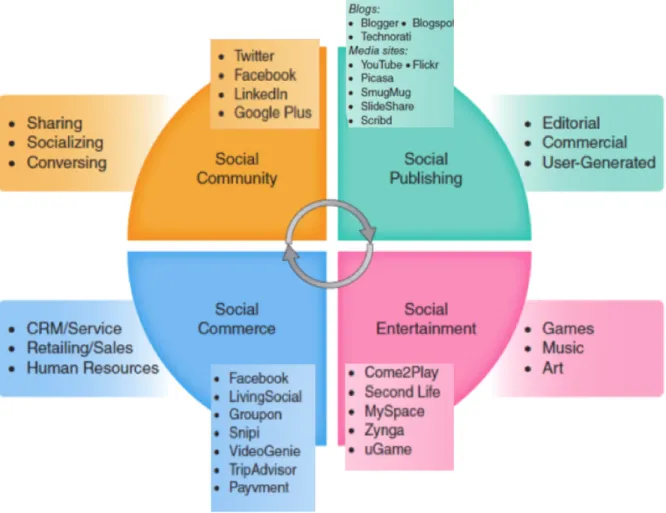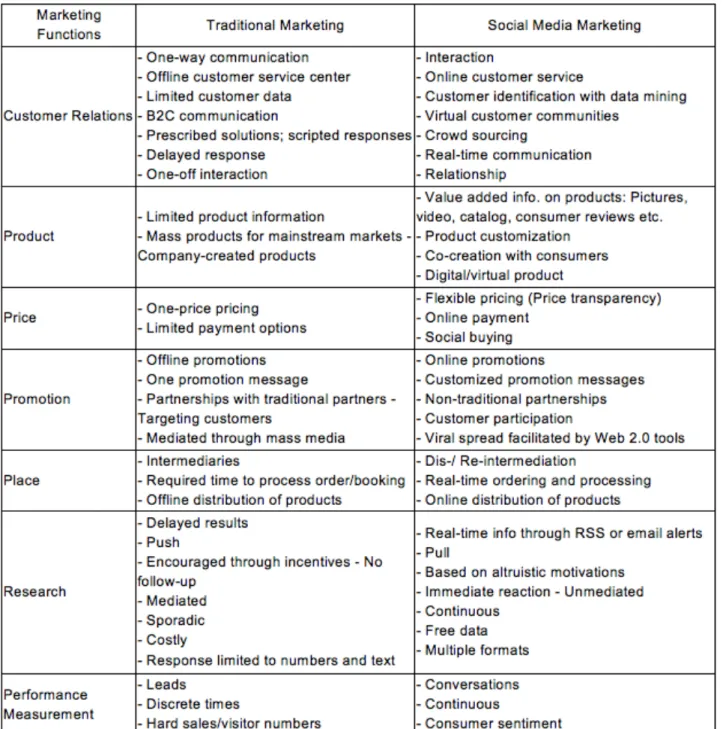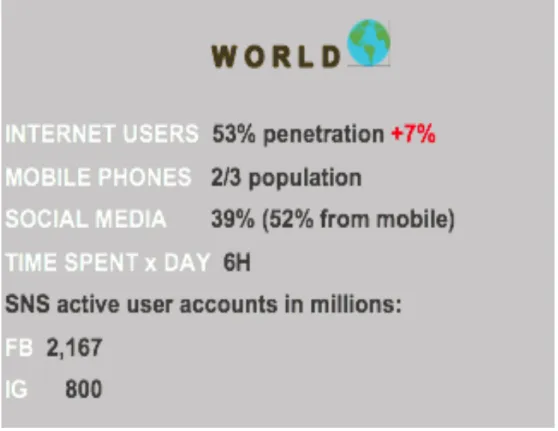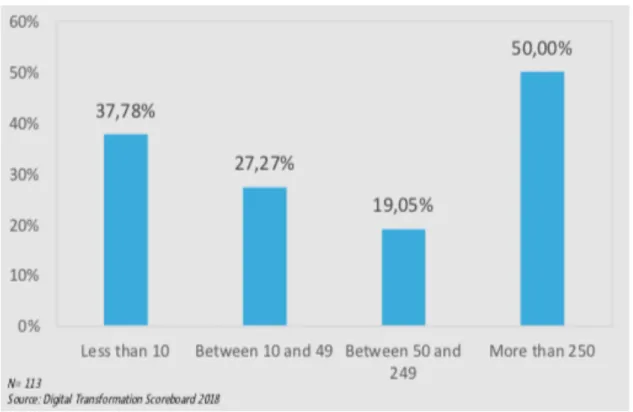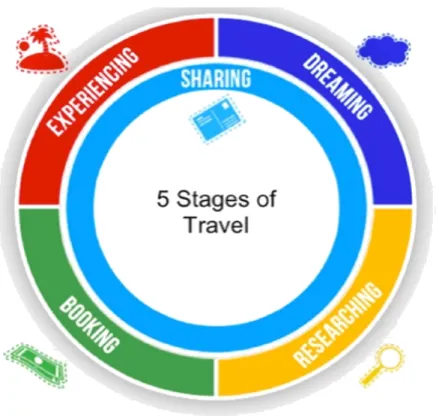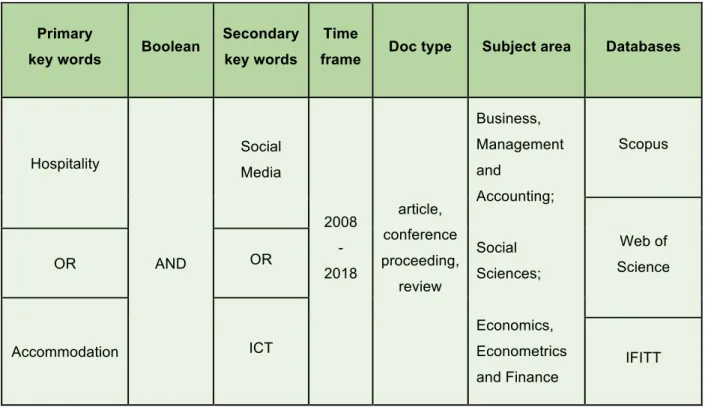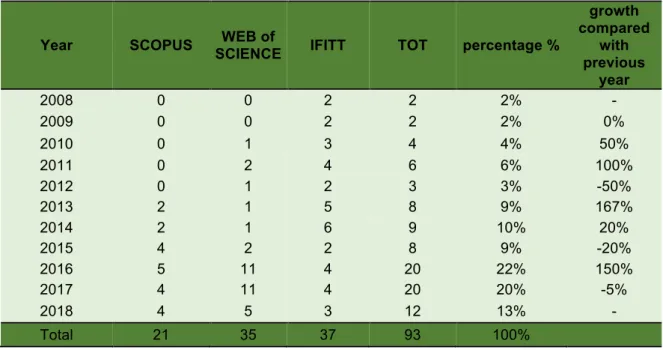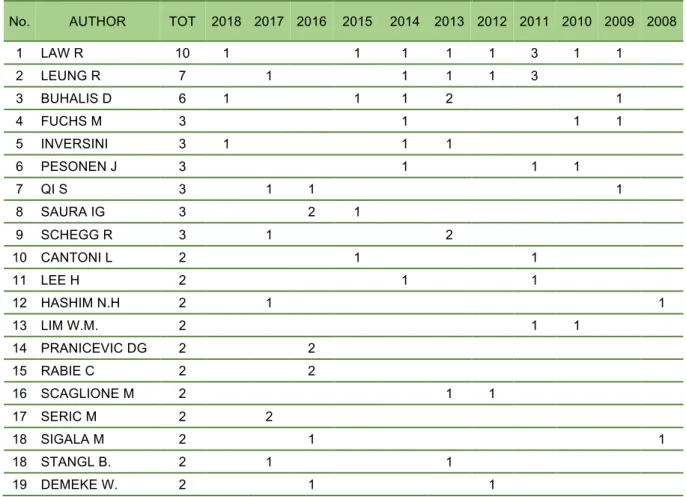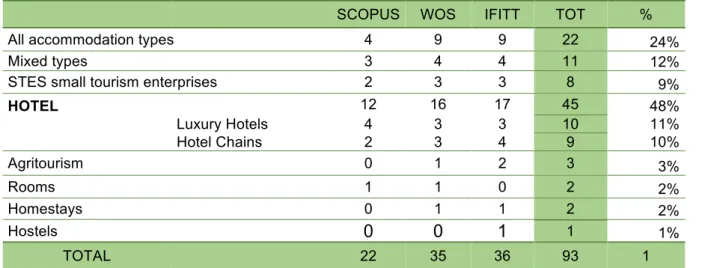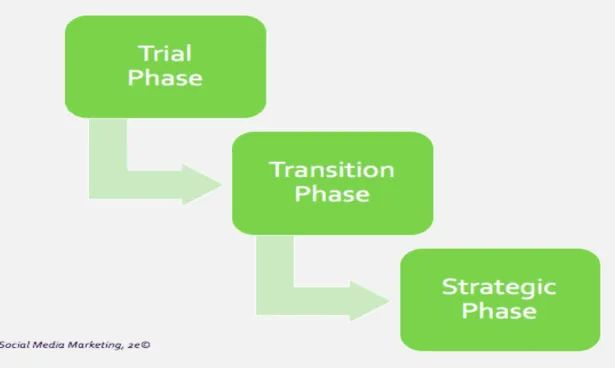DIPARTIMENTO DI ECONOMIA SOCIETÁ E POLITICA
CORSO DI DOTTORATO DI RICERCA IN ECONOMIA SOCIETÁ E DIRITTO CURRICULUM ECONOMIA E MANAGEMENT
XXXI CICLO
SOCIAL MEDIA
in the
TOURISM INDUSTRY
SECS P-08 RELATORE DOTTORANDA Chiar.mo Prof. Tonino Pencarelli Dott. Claudia Fraboni CO-RELATOREii
SOCIAL MEDIA
in the
TOURISM INDUSTRY
a dissertation
submitted to the department of Economics Society and Politics and the committee on graduate studies of the University of Urbino in partial fulfillment of the requirements for the
degree of doctor of philosophy
iv
This work is dedicated to my son Michelangelo,
my sweet little turtle.
I hope you may be inspired by my study.
"Education is the most powerful weapon
which you can use to change the world".
Acknowledgements
First of all I would express my sincere gratitude to Professor Tonino Pencarelli for allowing me to conduct this research under his auspices. I am especially grateful for his confidence and the freedom he gave me to do this work. As a thesis supervisor, Professor Pencarelli offered me his guidance and kind advice. I thank him for always beeing there to remind me my duties, for believing and trusting me and for offering me growth opportunities during the PhD career. It was a privilege for me to share of his exceptional scientific knowledge.
To my colleagues and friends of the Department of Economics, Social and Political Studies at the University of Urbino, to Gabriella and Margherita in particular, I thank them for their companionship and for supporting me throughout the PhD fellowship. I also thank them for the moments of leisure shared together, for all the meals, the discussions and laughs we had, which helped to overcome some more difficult moments. Thank you for cheering for me.
To my closer friends, and familiy I express my gratitude for their unconditional friendship, love, support and patience throughout these years.
A very special thank goes to my eight-years-old son Michelangelo for his tolerance and patience, and for putting up with me being a part-time mum for such a very long time.
vi
Contents
Acknowledgements ... 5Chapter 1
Introduction
1. Abstract ... 3 1. List of Figures ... 4 1. List of Tables ... 5 1.1 Introduction ... 61.2 Social media definition and classification ... 8
1.2.1 Social media ... 8
1.2.2 Social media marketing ... 17
1.3 Digital Society and Economy ... 23
1.4 The impact of social media on Tourism ... 31
1.5 List of References ... 35
1.5.1 Sitography ... 41
Chapter 2
Social Media in the Hospitality Industry - a literature review
2. Abstract ... 43 2. List of Figures ... 44 2. List of Tables ... 45 2.1 Introduction ... 46 2.2 Methodology ... 47 2.2.1 Research questions ... 49 2.2.2 Selection Criteria ... 51 2.3 Literature review ... 542.3.2.1 Year of publication ... 58
2.3.2.2 Journals ... 59
2.3.2.3 Authorship trend ... 61
2.3.2.4 Range of Industrial sectors ... 62
2.3.2.5 Geography ... 63
2.3.2.6 Type of publication... 66
2.3.2.7 Methodology and design ... 66
2.3.3 Analytical Literature review ... 68
2.3.3.1 Social media literature main streams ... 68
2.3.3.2 Literature on the impact of social media on hospitality firms, its usage and the perception of it ... 71
2.3.3.2.1 Topics ... 72
2.3.3.2.2 The impact of social media on hospitality firms ... 74
2.3.3.2.3 The use of social media and the perception of it ... 76
2.4 Conclusion ... 80 2.5 Limitation ... 83 2.6 Future research ... 84 2.7 List of References ... 86 2.7.1 Sitography ... 89 2.8 Appendix ... 90
Chapter 3
Social Media in the Hospitality Industry - an empirical research
3. Abstract ... 100 3. List of Figures ... 101 3. List of Tables ... 102 3.1 Methodology ... 103 3.1.1 Research target ... 112 3.2 Findings ... 113viii
3.3.4 Recommendations for further research ... 170
3.4 List of References ... 172
3.4.1 Sitography ... 175
3.5 Appendix ... 176
Chapter 4
Social Media in the Tour Operator Industry - a literature review
4. Abstract ... 178 4. List of Figures ... 179 4. List of Tables ... 180 4.1 Introduction ... 181 4.2 Methodology ... 182 4.2.1 Research questions ... 184 4.2.2 Selection Criteria ... 186 4.3 Literature review ... 1884.3.2 Descriptive Literature review ... 190
4.3.2.1 Year of publication ... 192
4.3.2.2 Journals and research areas ... 193
4.3.2.3 Authorship trend ... 196
4.3.2.4 Geography ... 197
4.3.2.5 Type of publication... 198
4.3.2.6 Methodology and design ... 199
4.3.3 Analytical Literature review ... 200
4.3.3.2.1 Topics ... 202
4.3.3.3 The impact of social media on Tour Operators ... 206
4.4 Conclusion ... 208 4.5 Limitation ... 210 4.6 Future research ... 211 4.7 List of References ... 212 4.7.1 Sitography ... 215 4.8 Appendix ... 216
Chapter 5
Social Media in Tour Operator Industry - an empirical research
5. Abstract ... 219
5. List of Figures ... 220
5. List of Tables ... 221
5.1 Introduction ... 222
5.1.1 The distribution channel ... 222
5.1.2 Tour Operators ... 225
5.2.1 Population ... 229
5.2.2 Online Visibility ... 230
5.2.3 Social media activity ... 234
5.2.3 User Generated Content analysis ... 235
5.3 Findings ... 236
5.3.1 Tour Operators' Online Visibility ... 236
5.3.2 Social media activity ... 245
5.3.3 User Generated Content analysis ... 254
5.4 Conclusion and implications ... 258
5.5 Limitation and further research ... 259
5.6 List of References ... 260
5.6.1 Sitography ... 263
Chapter 6
Conclusion
General conclusion and implications ... 264Bibliography and sitography
Additional bibliography ... 2682
Chapter 1
1. Abstract
The advances in Information and Communication technologies (ICT) and the phenomenal success in terms of adoption and usage levels of social media by the global society in the last decades, have caused paradigm shifts in how people connect and communicate with each other, how they express and share ideas, and even how they engage with products, brands, and organizations. In travel and tourism, the impact of social media has been even more extraordinary, bringing unprecedented opportunities and challenges, primarily due to the experiential nature of tourism products. The combined sector of travel and accommodation is heavily ICT dependent (Buhalis and Licata, 2002). Tourists are connected at each stage of travel and seek real time interaction with tourism suppliers 24 hours a day, seven days a week. A strong social media presence is, therefore, increasingly critical for tourism suppliers. This is true for both business to consumer companies such as hospitality firms, which need to directly and instantly interface with their customers, and also business to business companies, such as tour operators, since the disintermediation of the tourism supply chain has shortened the distance between the travel suppliers and tourists and the need to be connected is on the rise. Moreover, customer pressure has a strong influence on e-communication practices through travel agencies. The aim of this thesis is to observe the state-of-play of social media usage and knowledge by two opposite sides of the tourism supply chain. A predominantly BtoB industry (tour operators) and a BtoC industry (hospitality). A literature review research and an empirical research for each of the industries have been conducted. The results of the systematic reviews assess the need for further and deeper research on social media issues in the Hospitality business and, even more, in the Tour Operator Industry. The findings of the empirical researches indicate that tourism suppliers, both TO and hospitality firms, are generally lagging behind in social media integration and their perception of the positive impacts of its usage is still low. Managerial implications and recomendations for future research are provided.
4
1. List of Figures
Fig. 1. 1 Social media classification by Kaplan and Haenlein (2010) ... 11
Fig. 1. 2 Social Media Networks Infographic ... 13
Fig. 1. 3 Zones of Social Media and exemplar vehicles ... 14
Fig. 1. 4 Digital Marketing vs Social media Marketing ... 18
Fig. 1. 5 Digital around the world in 2018 ... 23
Fig. 1. 6 Digital in Italy in 2018 ... 24
Fig. 1. 7 Most active social media platforms in Italy 2018 ... 25
Fig. 1. 8 Overall fixed broadband coverage in Europe 2016 ... 26
Fig. 1. 9 Overall NGA broadband coverage in Europe 2016 ... 26
Fig. 1. 10 Italy's framework conditions for digital transformation ... 28
Fig. 1. 11 Digital economy and society index (DESI) 2018 ranking ... 28
Fig. 1. 12 Adoption of social media by European enterprises by company size ... 29
Fig. 1. 13 Percentage of EU enterprises with high (>6) Digital Intensity Index (2016) ... 30
1. List of Tables
Table 1. 1 Social Media Marketing Functions ... 19
Table 1. 2 Marketing Paradigm Shift ... 20
Table 1. 3 Types of media (Tuten Solomon, 2018) ... 21
6
1.1 Introduction
The advances in Information and Communication technologies (ICT) and the phenomenal success in terms of adoption and usage levels of social media (SM) by the global society in the last decades, caused paradigm shifts In how people connect and communicate with each other, how they express and share ideas, and even how they engage with products, brands, and organizations. Thanks to the new hardware and software technologies (mobile devices, wi-fi connection, apps), communication is now instant, real time, accessible everywhere and available 24 hours a day and 7 days a week. The internet, providing channels that contribute to the interactions and transactions between consumers and businesses (Gay et al. 2007), has drammaticaly changed the market rules. Netizens participate very actively in emerging technologies, so they have moved from being CONsumers to PROsumers (Toffler 1990)1 and according to Axel Bruns even PROusers2, with far more influence than ever before, contributing not just the money but market and design information, knowledge and ideas through User Generated Content (UGC).
The ICT and social media revolution has been so favourably welcomed by the global society, that it reached such a massive diffusion that would have been hard to be imagined at the beginning. So hard to be foreseen and so fast moving that many industries on the other hand are still working to catch up with this megatrend,
This study will focus on the impact of social media on the supply side, in particular on the Tourism Industry, where the impacts of ICTs have been even more extraordinary, bringing unprecedented opportunities and challenges, primarily due to the experiential
1 The term “prosumer” has been first used by Toffler in 1980 but in today’s world of the social web the term has transformed from meaning “professional consumer” to meaning “product and brand advocate.” Rather than simply “consuming” products, people are becoming the voices of those products and significantly impacting the success or failure of companies, products, and brands, particularly through their involvement on the social web. No longer are businesses completely in control of their products, brands and messages. The leaders of this shift are the members of the social web — bloggers, forum posters, social networking participants, and so on, who spread messages, influence people around the world, and drive demand. 2 According to Axel Bruns users are also as producers that put their User Generate Content (UGC) and ideas free on social media independently by their own motivation and desire (Bruns, 2006).
nature of tourism products. In the present work we will try to understand the state-of-play and the awareness of the importance of a social media presence for the hospitality and tour operator companies. The decision to analyse this two particular kind of businesses of the Tourism industry, was given by the interest in observing the different behaviours, in terms of social media implementation, of business to consumer companies (hospitality) and business to business ones (tour operators) along the same supply chain.
The existing literature on the matter has been first analyzed to find possible gaps of research. Chapter 2 is dedicated to a systematic review of the exant literature concerning the impact of social media on the Hospitality Industry, while chapter 4 is focusing on literature concerning the impact of ICTs on a BtoB sector, i.e. the Tour Operators industry. The research questions for both reviews are the followings:
• Do hospitality companies and tour operators use social media? • Which is their perception of social media?
• Which is the impact of social media on the hospitality businesses and tour operators?
The results of the above systematic reviews revealed a general lack of research on the use of social media by tourism providers. Thus, two different empirical researches have been carried out on each of the target industries. The one on the impact of social media on hospitality Industry (Chapter 3) is based on a questionnaire submitted to the Hospitality businesses of the Italian Medium Adriatic Regions (Emilia Romagna, Marche and Abruzzo). The other (Chapter 5), which focuses on the impact of social media on the Tour operators Industry is based on the observation of the social media activity of some of the Italian Tour Operators.
The main objective of both empirical researches is to understand to what extent hospitality managers and tour operators are using social media.
In this first chapter, which introduces the whole study, we will go deeper into the social media phenomenon, trying to describe it (Paragraph 1.2) and to figure out the scale and extent of it both in the society and economy (Paragraph 1.3).
8
1.2 Social media definition and classification
1.2.1 Social media
The variety of social media is so large, countless and fast evolving that it introduces a tough challenge of definition. As Jacka and Scott (2011) argue, "there is no single recognized definition of social media". Kaplan and Haenlein (2010), also note that the development of a systematic classification scheme for social media can be difficult, as new sites appear every day. Whenever wide and all-encompassing a definition may be, social media have evolved to include other tools and practices that were not conceived of only a few years or even a few months ago.
Wikipedia3, being part of the world, defines Social media as "interactive computer-mediated technologies that facilitate the creation and sharing of information, ideas, career interests and other forms of expression via virtual communities and networks"4. The Wiki, combining different scholars' definitions, recognizes some common features:
1. Social media are interactive Web 2.0 Internet-based applications.
2. User-generated content, such as text posts or comments, digital photos or videos, and data generated through all online interactions, is the lifeblood of social media. 3. Users create service-specific profiles for the website or app that are designed and
maintained by the social media organization.
4. Social media facilitate the development of online social networks by connecting a user's profile with those of other individuals or groups.
In a further attempt to give an exhaustive definition of social media, being fully aware that it may not be the most complete and ultimate one, some scholars' contributions should be taken into consideration. For instance, other and different characteristics have been recognised by Khan (2015) as being common to all social media: many-to-many,
3 Available at: <https://en.wikipedia.org/wiki/Social_media> [Accessed September 2018]
4 Kietzmann, Jan H.; Kristopher Hermkens (2011). "Social media? Get serious! Understanding the functional building blocks of social media". Buettner (2016), similarly, defines Social media as "a computer-mediated tool that allow people to create, share or exchange information, career interests, ideas, and pictures/videos in virtual communities and networks".
participatory, user owned, conversational, openness, mass collaboration, relationship oriented, and free and easy to use. Khan contends that there are two types of social media: the ones that are static, and the ones that are dynamic (reaction in real time).
Similarly, Mayfield (2008) envisoned some features shared by most or all SM:
Participation: social media encourages contributions and feedback from everyone who is
interested. it blurs the line between media and audience. Openness: most social media services are open to feedback and participation. They encourage voting, comments and the sharing of information. there are rarely any barriers to accessing and making use of content.
ConVersation: whereas traditional media is about “broadcast” (content transmitted or
distributed to an audience) social media is better seen as a two-way conversation.
Community: social media allows communities to form quickly and communicate effectively.
Inside the communities people share common interests, political issues etc.
Connectedness: most kinds of social media thrive on their connectedness, making use of
links to other sites, resources and people.
According to Ward (2010), social media is one type of online media accelerating communication like conversation in contrast with conventional media which doesn’t allow readers to participate in the creation of contents. Social media differ from traditional media in many ways, including quality, reach, frequency, usability, immediacy and permanence (Agichtein et al., 2008). Social media operates in a dialogic transmission system, many sources to many receivers (Pavlik and MacIntoch, 2015). This is in contrast to traditional media that operates under a monologic transmission model (one source to many receivers).
Furthermore, social media depends on mobile and web-based technologies to create highly interactive platforms through which individuals and communities share, co-create, discuss, and modify user-generated content. It introduces substantial and pervasive changes to communication between businesses, organizations, communities, and individuals (Kietzmann & Hermkens, 2011). Jacka and Scott (2011) offered their definition, contending that "social media is the set of Web-based broadcast technologies that enable the democratization of content, giving people the ability to emerge from consumers of content to publishers". Safko and Brake (2009) describe the phenomenon as
10
Kaplan and Haenlein (2010) assessed that social media as we know it today can be traced back more than two decades when users could already post public messages on sites such as Usenet5. The advent and availability of high-speed internet access has then led to a proliferation of sites and an explosion in their popularity (Kaplan and Haenlein 2010). The two scholars developed their own technical definition of social media: "social media is a group of Internet-based applications that build on the ideological and technological foundations of Web 2.0, and that allow the creation and exchange of user generated content”.
Web 2.0 is described "as a platform whereby content and applications are no longer
created and published by individuals, but instead are continuously modified by all users in a participatory and collaborative fashion". So, Web 2.0 might be seen as the ideological and technological foundation of social media. The mere publishing of content is less interactive and belongs to the earlier Web 1.0 era; collaborative projects, starting with blogs, belong to Web 2.0 (Kaplan and Haenlein 2010). Web 3.0, the Semantic Web, is the expected next stage. First envisioned by Tim Berners-Lee in 2006, this third iteration of the Web makes it possible for people and machines to collaborate6.
User-generated content (UGC) or User Created Content (UCC) describes the
various forms of media content that are created by and available to users. Kaplan and Haenlein (2010) go further and adopt the view of the OECD7 that content must meet three basic requirements to qualify as UGC:
• It must be published to all Web users or to a select group (which might exclude emails
5 Usenet is a worldwide distributed discussion system first established in 1980. Users read and post messages (called articles or posts, and collectively termed news) to one or more categories, known as newsgroups. Usenet resembles a bulletin board system (BBS) in many respects and is the precursor to Internet forums that are widely used today. Source: < https://en.wikipedia.org/wiki/Usenet> [Accessed: September 2018]
6 The Web will be a universal medium for data, information, and knowledge exchange. It will mark an era of collaboration of people, but also of people and machines. While some elements of Web 3.0 exist, especially the presence of services made possible by social software, the capture of user-generated data, and the mining and processing of big data, it is not yet fully realized. We remain in a stage known as Web 2.x. Shadbolt N., Hall W. and Berners-Lee T. (2006), “The Semantic Web Revisited,” IEEE Intelligent Systems 96-101
7 Organisation for Economic Co-operation and Development (2007) Working Party on the Information Economy PARTICIPATIVE WEB: USER-CREATED CONTENT DSTI/ICCP/IE(2006)7/FINAL Available at: <https://www.oecd.org/sti/38393115.pdf> [Accessed: May 2018]. In 2007 the OECD asserted that: "There is no widely accepted definition of UCC, and measuring its social, cultural and economic impacts are in the early stages". UCC is defined as: "i) content made publicly available over the Internet, ii) which reflects a certain amount of creative effortî, and iii) which is icreated outside of professional routines and practices".
or instant messages).
• It should demonstrate some creative effort and not simply replicate the work of another. • It must be created outside of professional routines and practices and not for a
commercial market.
Although UGC was available before Web 2.0 emerged, the combination of technology, economics (wider access to the tools of creation) and social influences (the rise of a generation of "digital natives" and "screenagers") has driven its development (Kaplan and Haenlein 2010). The two scholars further contend that social media have two key elements that can be used to classify them to some extent: social presence/media richness on the one hand, and self-presentation/self-disclosure on the other (Fig. 1.1).
Fig. 1. 1 Social media classification by Kaplan and Haenlein (2010)
The table shows how different types of social media involve different commitments from the user. It is important to recognize that the term social media encompasses a large array of specific types of media. Accordingly Kaplan and Haenlein suggest a categorisation:
Collaborative projects enable the joint and simultaneous creation of content by many
users. Examples include various ‘wikis’, such as Wikipedia. Some of these sites allow users to add, remove and change content; others are a form of ‘social bookmarking’, in that they allow the group-based collection and rating of internet links or media content.
Blogs the earliest form of social media, grew from personal web pages and usually
display date-stamped entries in reverse chronological order. Text-based varieties are still very popular.
12
personal profile page.
Social networking sites (SNS) allow users to connect by creating personal information
profiles and inviting friends and colleagues to have access to the profile and to send emails and instant messages. Profiles usually include photographs, videos, audio files, blogs and so on. Facebook and Myspace are examples of social networking sites.
Virtual game worlds are platforms that replicate a three-dimensional environment in
which users appear in the form of personalised avatars and interact according to the rules of the game. They have gained popularity with the support of devices such as Microsoft’s XBox and Sony’s PlayStation. An example is World of Warcraft.
Virtual social worlds allow inhabitants to choose behaviour more freely and to live (in
the form of avatars) in a virtual world similar to their real life. An example is Second Life.
Many authors have proposed different categorizations and each of them may classify social media in slightly different ways. For instance, the Wiki Wikipedia is to be included in the collaborative projects according to Kaplan and Haenlein, whereas it goes under content aggregators, i.e. applications that allow people to customize the content as they wish to, according to Lehtimäki et al. (2009). What matters to the purpose of this study is to give an idea of what will be discussed in the next chapters.
A definition by Boyd and Ellison (2008) expands on the definition of social
networking sites (SNS): "web-based services that allow individuals to 1) construct a public
or semi-public profile within a bounded system, 2) articulate a list of other users with whom they share a connection, and 3) view and traverse their list of connections and those made by others within the system. The nature and nomenclature of these connections may vary from site to site". Social Networking Sites also vary with the security settings users set for their profiles, which then differently allow others to access the profile and the material they have posted to the site. Social networking sites might seem a recent innovation, but there is plenty of evidence to the contrary. Dating sites are, for instance, sometimes considered the first social networks8. In any case, SixDegrees, launched in 1997, is widely recognised as being the first modern social network9.
8 The first dating sites cropped up as soon as people started going online. They allowed users to create profiles (usually with photos) and to contact other users but rarely allowed to keep a friends list.
9 Six Degrees allowed users to create a profile and to become friends with other users. While the site is no longer functional, at one time it was actually quite popular and had around a million members at its peak.
A very useful infographic by the american art director Isabella Kinkelaar10 Fig. 1.2) gives a clear idea of the most common and widespread Social Networking Sites landscape today, of their characteristics and of the best ways for corporations to take advantage of these. As everything that concerns the fast moving and ever changing world of social media and ICTs, this map may become out of date in less than a while, but I found it useful to observe the social networking sites panorama at a glance and to unravel the tangled mess about which SNS does what.
Fig. 1. 2 Social Media Networks Infographic
To conclude this, which is certainly not the most complete review possible of social media definitions and categorisations, I may not forget to mention Tuten and Solomon theories which have been adopted as a Framework for the whole study. According to the authors: "Social media are the online means of communication, conveyance, collaboration, and cultivation among interconnected and interdependent networks of people, communities,
14
and organizations enhanced by technological capabilities and mobility".
Social media are socially enabled online channels, and like other media, there are numerous vehicles within each channel. Part of the complexity of social media is due to the sheer quantity of channels and vehicles, with new ones coming online all the time.
Tuten and Solomon (2015) tried to organize the social media space grouping similar channels into four zones (Fig. 1.3) The four zones focus upon the most important functions of each social media platform. Some areas overlap two or even more zones.
Fig. 1. 3 Zones of Social Media and exemplar vehicles
Social communities describe channels of social media that focus upon relationships
and the common activities people participate in with others who share the same interest or identification. They feature two-way and multi-way communication, conversation, collaboration, and the sharing of experiences and resources. All social media channels are
built around networked relationships, The channels in the social community zone include social network sites, message boards and forums, and wikis. All emphasize individual contributions in the context of a community, communication and conversation, and collaboration.
Social publishing is the production and issuance of content for distribution via social
publishing sites. These aid in the dissemination of content to an audience by hosting content while also enabling audience participation and sharing. Social publishers may be categorized into four use groups: 1) individual users, 2) independent professionals, 3) professional contributors associated with organizations such as news media, and 4) brands. The channels of social publishing include blogs, microsharing sites, media sharing sites, and social bookmarking and news sites. These enable participation and sharing, just as social communities do. The distinction between these two zones is in the primary orientation. The orientation of social communities is networking while that of social publishing is knowledge-sharing.
The social entertainment zone encompasses events, performances, and activities designed to provide the audience with pleasure and enjoyment, experienced and shared using social media. The distinction between the zones of social publishing and social entertainment is the orientation: Knowledge-sharing versus entertainment-sharing. Social games are, at this stage, the most advanced channel in the social entertainment zone. Examples of social game vehicles include Candy Crush and Mafia Wars.
The social commerce zone refers to the use of social media in the online shopping, buying, and selling of products and services. Social commerce encompasses social shopping, social marketplaces, and hybrid channels and tools that enable shared participation in a buying decision. Social shopping is the active participation and influence of others on a consumer’s decision-making process, typically in the form of opinions, recommendations, and experiences shared via social media. Channels include reviews and ratings (on review sites like Yelp or branded e-commerce sites), deal sites (like Groupon), deal aggregators (aggregate deals into personalized deal feeds), social shopping markets (online malls featuring user-recommended products, reviews, and the ability to
16
conversion functionality. In addition, organizations can socially enable aspects of their traditional e-commerce websites by using tools such as Facebook Connect (a Facebook tool that allows users to log in to other partnering sites using their Facebook identities) and share applications (tools that let users share what they are buying) (Tuten and Solomon, 2018).
In an ever-changing and fast moving social media landscape, the intent of this review is not to pursue the ultimate truth, which would be impossible to reach and too difficult to maintain. Merely, the purpose of the review of social media definitions and classification is to give an idea of the main features of this horizontal revolution and give a conceptual basis for understanding the present study about the impact of social media on the hospitality and travel industry. To do so, prior to understanding how the global society and the italians are coping with this big shift from the classical mass media models to the new media paradigms, some distinctions must be made.
Firstly, it is useful to briefly elucidate what ICT entail and how they relate to social media. ICT is used as a general term for diverse set of technologies which enable users to create, access, disseminate, store, manage, and communicate information in a digital format. ICT include computer hardware and software applications, encompassing: mobile phones, computers, network hardware, internet, telecommunication systems and so on, as well as the various related services and applications. In recent years there has been a groundswell of interest in how computers and internet can best be harnessed to improve social communication at different levels, which has propelled research and innovation in the area of ICT and social digital media (SDM), leading to the emergence of what has come to be known as participatory technologies such as Web 2.0. Overall, although ICT and social media are conceptually different, they are intertwined and inextricably connected. And they converge when mobilised as resources for or employed as means in social change, a process that entails altering social patterns of a society, which can involve economic development, political progress, cultural change, social revolution, etc11.
Secondly, the difference between Digital Media and social media should be set. Though social and digital share similar attributes, they are not the same thing. "Digital is the
11 <http://wpmu.mah.se/nmict11group1/2011/10/30/2-ict-and-social-media-definitional-issues-and-the-relationship> [Accessed: September 2018]
infrastructure, the plumbing and wiring, but social is the behavior and quite possibly the glue"12. Digital media is an all encompassing term covering anything that is online or digital including mobile, web, tv etc. Social is a subset of digital, just one of the available channels of digital. Digital media per se is any medium of communication which uses digital content. It can be either one way or two way communication. Whereas Social media is the communication channel where users interact and contribute in creating content.
Finally, one more distinction should be made for the understanding of the present study and it refers to marketing. It may be useful to clarify what the notion of Social Media
Marketing encompasses and how it relates to traditional marketing and Digital Marketing.
1.2.2 Social media marketing
Just as Digital Media is the umbrella term used to encompass any medium of communication which uses online and digital content, including social media, so Digital marketing embraces all marketing efforts used to build awareness and increase engagement on digital platforms, including social media marketing.
The major components of Digital Marketing are: Internet Marketing, i.e. blogging, email marketing, web marketing, SEM (search engine marketing including SEO and Pay-per-click advertising), smartphones, mobile markets (i.e. Google Play, Apple Store), online banner advertising, etc. and Social Media Marketing; Non-Internet digital channels, i.e.
Television, Radio, SMS, digital billboards (indoor and outdoor). Thus, as the diagram below shows, social media is just one of the available channels of digital marketing (Fig. 1.4).
18 Fig. 1. 4 Digital Marketing vs Social media Marketing
According to Tuten and Solomon (2015) "Social media marketing is the utilization of social media technologies, channels, and software to create, communicate, deliver, and exchange offerings that have value for an organization’s stakeholders".
Similarly as the ICT revolution has changed the way society communicates, the advent and adoption of social media is changing the way brands and consumers interact. Traditional marketing focuses on push messaging, using a large dose of one-way broadcast and print media to reach a mass audience in a top-down communication. This means that messages are delivered to audiences whether they want to receive them or not, and regardless of whether these messages are directly relevant to their unique needs. There are minimal opportunities for interaction and feedback between consumers and the organization, and employees who interact directly with customers, mediate these dialogues.
With social media marketing, the ability for consumers to interact and engage with brands or organizations is greatly enhanced. Social media channels give consumers unparalleled access and interaction possibilities. Consumers discuss, contribute, collaborate, and share with companies and with each other. The culture of marketing has shifted to an informal one focused on the belief that customers are in control. Social media are not a substitute for traditional marketing communications, but they are also more than a complement to traditional methods (Tuten and Solomon, 2018).
Social media marketing is based on traditional marketing but adopts a fundamentally different philosophy in terms of the way interactions with potential and actual customers are structured. As illustrated by Yoo and Gretzel (2010), social media marketing functions span across all elements of marketing (Table 1.1). Therefore, social media marketing efforts should be seen as all-encompassing and as complementary extensions of other marketing efforts instead of a replacement (Evans, 2008).
20
Birch (2011) describes social media marketing as being focused on 4 R’s rather than the traditional 4 P’s (Table 1.2). Gunelius (2011) calls for well-planned, active, and continuous engagement with influential consumers. This requires intricate knowledge of the social media types and their users, a long-haul commitment, and continuous engagement, through interesting content.
Table 1. 2 Marketing Paradigm Shift
CLASSIC MARKETING SOCIAL MEDIA MARKETING
Product Price Place Promotion Relationship Return on Engagement Reach based on Relevance Reputation
Tuten and Solomon (2018) contend that there are two overarching objectives relevant to the use of social media marketing as part of a brand’s promotional mix:
1 Extend and leverage the brand’s media coverage.
2 Influence the consumer throughout the decision-making process.
According to the two scholars, when it comes to acquiring space in media to distribute brand messages, marketers or organizations have access to three core types of media:
Paied media: those for which monetary fees are asked for the placement of
promotional messages in channels capable of reaching a mass audience, including purchasing spaceto deliver messages and securing endorsement.
Owned media: channels the company controls. Corporate websites and
e-commerce sites, corporate blogs, advergames, and alternate reality games (ARGs) all represent forms of owned media.
Earned media: those messages that are distributed at no direct cost to the company
and by methods beyond the control of the company. Word-of-mouth (WOM) communication and publicity are important forms of earned media.
In Table 1.3 are shown the forms of paid, earned, and owned media that are possible in each of the zones of social media marketing.
Table 1. 3 Types of media (Tuten Solomon, 2018)
More simply, Barefoot & Szabo, 2010 contend that social media marketing is using social media channels to promote a company and its products. The main difference is that the audience of the marketing messages not only consumes but also actively creates marketing contents (Evans, 2008). Engaging users’ interest and participation is the critical point in social media marketing campaigns (Parsons et al., 1998). Evans (2008) sees it as one of three pillars: engagement, action and loyalty. It assumes an active audience of prosumers (Toffler, 1980) who want to interact with marketers or companies beyond the immediate sales transaction. It further acknowledges that loyalty in social media cannot be assumed, but must be actively assured (Kozinets, 1999). Social media marketing thus falls within the new marketing logic described by Vargo and Lusch (2004), which, instead of focusing on tangible resources, embedded value, and transactions, fully embraces intangible resources, co-creation of value, and relationships.
Social media marketing is essentially about building relationships (Barefoot & Szabo,
Zone Paid Media Earned Media Owned Media
Social community Ads Conversations,
Shared content, Influence impressions, Likes, fans
Controlled profiles
Social publishing Endorsements, Branded channels
Embeds, comments, shares, links, search rankings
Corporate blogs, branded media sharing sites
Social entertainment Social game ads In-game interactions Advergames, branded ARGs
Social commerce Sales promotions Reviews/ratings Referrals Group buys Social shopping
22
(Mangold & Faulds, 2009). Consequently, social media marketing is concerned with how conversations can be prompted, promoted and monetized (Safko & Brake, 2009). Consumers are active participants and equal partners in these conversations who co-create value together with organizations by exchanging resources and information (Vargo & Lusch, 2004). It is important to note that this means companies cannot control these conversations but can only try to influence them. User-generated contents can either reinforce marketing efforts or beat marketers at their own games (Evans, 2008). It also implies that companies need to obtain an intricate understanding of how meaning creation happens in a particular social media type and what use conventions have emerged so that they can manage conversations in a way that is appreciated rather than seen as intrusive by the consumers.
Practically, the main benefits of using social media marketing, according to the literature, include reducing administrative costs, increasing awareness (Jones, Borgman & Ulusoy 2015), enabling small businesses to compete with large businesses and to access global markets, enabling 24/7 operations to be provided, thereby overcoming the time limitations and being less expensive and complex to implement (Kim, Lee & Lee 2011).
1.3 Digital Society and Economy
The recent Digital in 2018 Global Overview13 Report from We Are Social and Hootsuite (Fig. 1.5) revealed that more than half of the world’s population now uses the internet and that more than half of the world’s web traffic comes from mobile phones (52%). This means that one in two citizens of the world have the possibility to be connected at any time and everywhere. Global social media14 users in 2018 were 4 billion, equaling a 53% penetration, 7% more than the last year. And this data are still growing.
Fig. 1. 5 Digital around the world in 2018
Elaboration from 2018 Digital Yearbook – We are social & Hootsuite - January 2018
Internet users penetration in Italy is much over the worlds' average, covering the 73% of the entire population (Fig. 1.6) and only one point below the European penetration (74%). Also, considering that every Italian adult (aged 15+) has at least one mobile phone, the time spent per day on the internet is 8 minutes above the world average.
24 Fig. 1. 6 Digital in Italy in 2018
Elaboration from 2018 Digital Yearbook – We are social & Hootsuite - January 2018
This means that Italians have become very social and connected over the last years and are still increasing this trend. Anyway, if more and more italians are online, the skills levels remain low and the Italian Internet users engage in online activities much less than the EU average does15. In other terms, Italians do use internet more than 8 hours a day, every day only engaging in few online activities. The most practiced social media activities among the Italian netizens are certainly those related to Social Media Networking.
According to the Digital Year Book 201816 the most used SNS in Italy is Youtube, immediately followed by Facebook (Fig. 1.7), which is, instead, by far the most used SNS globally (2.167 million monthly active users accounts against the 1,500 of Youtube).
15 European Commission, Digital Economy and Society Index 2017 - Italy
16 2018 Digital Yearbook – We are social & Hootsuite - January 2018 Available at:< https://wearesocial.com/blog/2018/01/global-digital-report-2018> [Accessed February 2018]
Fig. 1. 7 Most active social media platforms in Italy 2018
The Italian economy for its part, has been lagging behind the very fast progress in ICTs and the digital transformation for many years in the past, being among the last countries to catch up in Europe. The main reason for this was the delay in technological infastructure (Wi-fi and Broadband diffusion) which has been finally recovered in the last years (Table 1.4; Fig. 1.8; Fig. 1.9)17. Today, Italy is among the first Countries in Europe for
fixed broadband coverage and is performing around the average for the Next Generation Access coverage18 that rose significantly from 41% of households in 2015 to 72% in 2016.
Table 1. 4 Broadband coverage in Italy compared to Europe
26 Fig. 1. 8 Overall fixed broadband coverage in Europe 2016
The Italian Governement has given a boost to the long awaited Italian economy digitalisation and connectivity with the National Plan "Industry 4.0"19 launched in 2016. The Plan puts in place horizontal measures i.e. adopting a technology neutrality approach, addressed to all types of enterprises, regardless of their size or sector, with the purpose to boost the investment in new technologies, research and development, and revamp the competitiveness of Italian companies. The plan is complemented by an Ultra Broadband Plan, to improve connectivity and also includes funding to Italian Universities, tax breaks and venture-capital support.
Italy has made significant progress mainly thanks to the large increase in NGA coverage. In the past two years, according to the Europe’s Digital Progress Report20, published in 2017, Italy has had a 19.7% growth in corporate digitisation among the European countries. While, for the Digital Transformation Scoreboard 201821 "overall, Italy’s
profile is rather pronounced, featuring solid performances in the technological and entrepreneurial fields.
Italy performs strongly in the field of entrepreneurial culture, and also receives a solid score in the field of digital transformation and e-leadership. Meanwhile, digital skills and ICT start-ups remain a shortcoming for the italian firms (Fig. 1.10).
19 The National Plan launched in 2016 by the Italian Ministry of Economic Development, known as "Industry 4.0." provides investments of 13 billion euro, which will be devoted to innovation and research. The goal is to reach 10 billion private investment for 2017: a major package of tax breaks will contribute to achieve this result. Public intervention will follow the private sector investment, amounting to 24 billion euro until 2020. These will be invested in 2017 in technology and goods and, by 2020, in research and development. The intentions of the government are oriented towards obtaining 200,000 students and 3,000 specialized managers within the industry 4.0. In addition to investments, the National Plan Industry 4.0 includes significant deductions and incentives in support of specialized training. Available at: http://www.mise.gov.it [Accessed: 3 September 2018] 20 European Commission Europe's Digital Progress Report 2017 country profiles - Telecom country reports (2017) available at: <https://ec.europa.eu/digital-single-market/en/news/europes-digital-progress-report-2017-country-profiles-telecom-country-reports> [Accessed: August 2018]
28 Fig. 1. 10 Italy's framework conditions for digital transformation
Source: European Commission
According to the Digital Economy and Society Index 201822, Italy ranks 25th (Fig.
1.11). The use of digital technologies by enterprises and the delivery of online public services is close to average. Compared to last year, Italy made progress on Connectivity, in particular through improvements in NGA access. However, its low performance in digital skills risks acting as a brake on the further development of its digital economy and society. Italy is, thus, closing the gap with the EU on business digitisation, however, rarely use electronic sales channels.
Fig. 1. 11 Digital economy and society index (DESI) 2018 ranking
22 European Commission Digital Economy and Society Index 2017 available at: < https://ec.europa.eu/digital-single-market/en/desi> [Accessed: August 2018]
Also, data from the Global Information Technology Report 2016 (Network readiness Index) of the World Economic Forum, show that Italy is one of the countries that improved the most during the last year its ability to leverage information and communication technologies to improve its competitiveness and the well-being of its population23.
If the Italian economy digitalisation has made great progress in the last couple of years, there is, however, a different speed in the digital transformation process based on the size of the businesses. In general, large groups in Europe are more social than the SMEs, many being already at an advanced stage, often even ahead of their foreign competitors, while small and medium-sized enterprises lag far behind24. (Fig. 1.12).
Fig. 1. 12 Adoption of social media by European enterprises by company size
30
The speed of the digitisation process varies also among the different economic sectors. Apart for the different segments of the ICT sector (from telecoms to the manufacture of computers) that tend to be the most digitised sectors of the economy, others such as accommodation, travel agencies, cultural industries (publishing, film&television, music) and the wholesale trade are highly digitised in Europe. The pattern of sectoral variability in digitisation is similar across EU countries, with some positive exceptions of higher digitisation than expected, if looking only at the countries and sectoral marginal averages, among which the Accommodation in Italy, Portugal and Slovenia (Fig. 1.13)25.
Fig. 1. 13 Percentage of EU enterprises with high (>6) Digital Intensity Index across economic sectors (2016)
Source: Eurostat Community survey ICT usage and e-commerce in enterprises
25 European Commission Europe's Digital Progress Report 2017 Available at: <https://ec.europa.eu/digital-single-market/en/news/europes-digital-progress-report-2017> [Accessed: June 2018]
That said, the hospitality managers have no more infrastructural obstacles to delay their digital transformation. It is all upon their will and awareness.
1.4 The impact of social media on Tourism
The figures above give a clear idea of how this new communication platforms may have led to both vital changes and opportunities, but also threats, in business making. Using social media offers businesses an opportunity especially in terms of reaching their target audiences (Meredith, 2012) in a cheap and very fast way. Also, building much more interactive relationships (Papasolomou & Melanthiou, 2012) in order to disclose the consumers needs and desires and be able to offer more value to them. Indeed, social media are significant networks of consumer knowledge. But, with billions of users, social media are also high risk and threats. Social media are giving consumers a venue to voice their opinions, recommendations and complaints.
Research on word of mouth (WOM) effects provides plenty of evidence that a satisfied customer may tell some people about his experience with a company, but a dissatisfied one will tell everybody he meets (Chatterjee, Patrali, 2001). Therefore, online consumer-generated reviews (e-WOM26) and other content posted on the web can have a dramatic impact on brands’ reputations. Monitoring this activity and managing the interactions with complaining consumers, as well as mapping and leveraging influencers in social media to shape corporate brand perceptions becomes vital to every business. The point is that to get the best of the opportunities given by the advances in ICT and to manage the threats, social media should be an indispensable part of organizations’ strategies and practices (Peters et al., 2013).
32
In travel and tourism, the impacts of social media have been even more extraordinary, bringing unprecedented opportunities and challenges, primarily due to the experiential nature of tourism products: purchases are considered risky and therefore decision making processes are information intensive. Information technologies (IT) have been recognized as one of the greatest forces causing change in the Hotel industry (Law, Leung, Au, & Lee, 2013). Information technologies have dramatically changed the way we travel (Benckendorff, Sheldon, & Fesenmaier, 2015).
In particular, the emergence of Web 2.0 including social media and user-generated websites have enabled travelers to communicate, interact, and form relationships with destinations, travel-related businesses, and other travelers (Boyd & Ellison, 2007; Hudson & Thal, 2013). Mobile technology has also changed the nature and timing in which travelers use travel information (i.e. real-time information searching) (Gretzel & Fesenmaier, 2009; Gretzel, Fesenmaier & O’Leary, 2006; Tussyadiah, 2015; Xiang, Magnini, & Fesenmaier, 2015). Tourists receive and share information online and form virtual communities on a whole array of social media software. These encompass a variety of different types of ICT tools and take many different forms. Some of the most popular ones are wikis, blogs and microblogs, social networks, media sharing sites, review sites, and voting sites (Stillman & McGrath, 2008; Zarrella, 2010). Tourists share their travel images on Facebook, Instagram, Flickr, upload videos to Youtube, write personal stories on Travelblog, provide reviews on TripAdvisor, Foursquare among others and publish updates about their tourism experience on many different social networks. Hence, the participatory web has enabled new kinds of tourism interactions (such as electronic word-of-mouth), which complement and expand the experience of physical travel in diverse ways.
These technology-induced changes have led to a significant shift in the role of travelers from passive information recipients to active information creators (Wang, Xiang, & Fesenmaier, 2014b). Many scholars argued that social media combined with the popularity of mobile devices reshape the way travelers enjoy the trip and eventually, restructure the entire tourism experience (Gretzel, 2010; Gretzel & Fesenmaier, 2009; Kah & Lee, 2014; Wang et al., 2012; Wang, Xiang, & Fesenmaier, 2014a; Xiang et al., 2015).
Social media represent important tools supporting the travel planning process and subsequent behaviors throughout the entire trip by fulfilling a number of specific needs of
travelers at a particular moment across all stages of the trip. According to Gretzel there are three main stages of a travel: pre-trip, during-the-trip, and post-trip (Gretzel & Fesenmaier, 2009; Gretzel et al., 2006; Vogt & Fesenmaier, 1998; Wang, Park, & Fesenmaier, 2012). Minazzi (2014) declined the three stages in further sub-stages: need recognition, information search, evaluation of alternatives and booking/purchase as a part of the pre-trip phase (anticipatory), the consumption as part of the during-trip stage (experential) and post consumption as part of post-trip (reflective). Whereas the Google Travel Study, commissioned to Ipsos MediaCT in 2014 recognised that the stages of travel are five: Dreaming; Researching; Booking; Experiencing and Sharing (Fig. 1.14)27.
Travelers usually exhibit a variety of different behaviors (i.e. sharing, creating, searching, etc.) throughout all stages of the tourism experience, which in turn results in highly idiosyncratic trip-related decisions and experiences (Gretzel et al., 2006; Wang et al., 2012, 2014b).
Fig. 1. 14 The five stages of travel
34
Social media have a great influence on the tourists' decisions or behaviours throughout all the stages of travel and tourism experience. User generated content and eWOM on social networks can influence the transformation process of a need in a specific desire. Research confirms how UGC is considered particularly important during the travel planning (Gretzel 2007; Xiang et al. 2014) as a source of information. For example, online comments, photos and videos of other travellers can help selecting information, making decisions and even changing mind and plans. According to Fotis (2012) a large majority of travellers investigated made some sort of changes to the original travel plan after having consulted online UGC.
Travelers now have the privilege of instantaneous access to information across the web in the form of Buzzfeed guides, TripAdvisor reviews28, and travelers’ Instagram photos
depicting their latest vacation. This real-time access to relevant tips and, often, crowd-sourced information, has ultimately changed the way travelers approach planning a trip, from inspiration (dreaming) to booking and experiencing.
This means that properly using social media is a matter of survival for tourism companies operating in the digital era. The technological environment continuously offers new web-based solutions and tools to companies for the purpose of advancing marketing activities. Such solutions and tools are also increasingly available for SMEs because their uptake requires minimal financial investment, if any. However, this then results in new requirements concerning organisational capabilities and skills. Consequently, the former dilemma of whether ‘to use or not to use ICT’ in tourism SMEs is now becoming more about how to develop organisational marketing capabilities through the use of social media to ensure the competitiveness of a company (Meriläinen, 2017).
Are Italian tourism companies and practicioners ready for this?
28 Tripadvisor the world's largest travel site, reached 661 millions reviews and opinions in 2018 (290 pieces of content are posted every minute of every day) covering the world's largest selection of travel listings worldwide with approximately 7.7 million accommodations, airlines, experiences, and restaurants. Source: <https://tripadvisor.mediaroom.com/us-about-us> [Accessed: September 2018]
1.5 List of References
• Agichtein, E., Castillo, C., Donato, D., Gionis, A., and Mishne, G. (2008). Findinf high-quality content in social media. In Proceedings of the 2008 International Conference on Web Search and Data Mining, New York, NY ACM Digital Library
• Barefoot, D., & Szabo, J. ( 2010) Friends With Benefits: A Social Media Marketing Handbook, San Francisco: No Starch Press
• Benckendorff, P. J., Sheldon, P. J., & Fesenmaier, D. R. (2015). Tourism information technology (2nd ed.). Wallingford, UK: CABI Publishing.
• Boyd, D. M., & Ellison, N. B. (2007). Social network sites: Definition, history, and scholarship. Journal of Computer- Mediated Communication, 13(1), 210–230. doi:10.1111/ j.1083-6101.2007.00393.x
• Bruns A. (2006). Towards produsage: Futures for user-led content production. In Sudweeks, Fay, Hrachovec, Herbert, & Ess, Charles (Eds.) Cultural Attitudes
towards Communication and Technology 2006, 28 June - 1 July, Tartu, Estonia.
• Buettner, R. (2016). Gettinga Job via Career-oriented Social Networking Sites: the weakness of ties. Paper presented at the 49th Annual Hawaii International Conference on System Sciences, Kauai, HI. DOI:10.1109/HICSS.2016.272
• Casini, S. (2018). "The digital transformation? Many have thrown away at least half a million." Industria Italiana. February 7, 2018
• Chatterjee, Patrali (2005), “Changing Banner Ad Executions on the Web: Impact on Clickthroughs and Communication Outcomes,” Advances in Consumer Research, 32(1), 51-57.
• Constantinides, E. & Fountain, S.J., 2008. Web 2.0: Conceptual foundations and marketing issues. Journal of Direct, Data and Digital Marketing Practice, 9(3), pp.231–244.
• European Commission (2017) Europe's Digital Progress Report (EDPR) Available at: <https://ec.europa.eu/digital-single-market/en/news/europes-digital-progress-report-2017>
36
• European Commission (2018) Digital Transformation Scoreboard 2018. Available at: <https://ec.europa.eu/growth/toolsdatabases/dem/monitor/sites/default/files/Digital% 20Transformation%20Scoreboard%202018_0.pdf>
• Evans D., Social Media Marketing: The Next Generation of Business Engagement. Wiley Publishing
• Fotis, J., Buhalis, D., & Rossides, N. (2012). Social media use and impact during the holiday travel planning process In: Fuchs, M., Ricci, F. and Cantoni, L., eds. Information and Communication Technologies in Tourism 2012. Vienna, Austria: Springer-Verlag, pp. 13-24.
• Gay, R., Charlesworth, A., & Esen, R. (2007). Online marketing: A customer-led
approach (pp. 1–32). New York, NY: Oxford University Press.
• Gretzel, U., Hwang, Y.-H., & Fesenmaier, D. R. (2012). Informing destination recommender systems design and evaluation through quantitative research. International Journal of Culture, Tourism and Hospitality Research, 6(4), 297–315. • Gretzel, U. (2010). Travel in the network. In M. Levina & G. Kien (Eds.), Post-global
network and everyday life (pp. 41–58). New York, NY: Peter Lang.
• Gretzel, U., & Fesenmaier, D. R. (2009). Information technology: Shaping the past, present, and future of tourism. In T. Jamal & M. Robinson (Eds.), The Sage handbook of tourism studies (pp. 558–580). Thousand Oaks: Sage.
• Gretzel, U. & Yoo, K. H (2008). Use and Impact of Online Travel Reviews. In O'Connor, P., Höpken, W. & Gretzel, U. (Eds.). Information and Communication
Technologies in Tourism 2008, 35-46. Vienna, Austria: Springer.
• Gretzel, U., Fesenmaier, D. R., & O’Leary, J. T. (2006). The transformation of consumer behaviour. In D. Buhalis & C. Costa (Eds.), Tourism business frontiers: Consumers, products and industry (pp. 9–18). Burlington, MA: Elsevier.
• Gunelius, (2011) 30 minute Social Media Marketing: Step by Step Techniques to Spread the Words about your Business. McGraw-Hill, USA (2011).
• Hudson, S., & Thal, K. (2013). The impact of social media on the consumer decision process: Implications for tourism marketing. Journal of Travel & Tourism Marketing, 30(1–2), 156–160. doi:10.1080/10548408.2013.751276
• Ipsos MediaCT, (2014) Google Travel Study, The 2014 Traveler’s Road to Decision Available at: <http://storage.googleapis.com/think/docs/2014-travelers-road-to-decision_research_studies.pdf>
• Jacka, J. M. and Scott, P. R. (2011). Auditing social media: A governance and risk guide. Wiley
• Jones, N., Borgman, R. & Ulusoy, E., 2015, ‘The impact of social media on small tourism business’, Journal of Small Business & Enterprise Development 22(4), 611– 632. https://doi.org/10.1108/JSBED-09-2013-0133
• Kah, J. A., & Lee, S.-H. (2014). Beyond adoption of travel technology: Its application to unplanned travel behaviors. Journal of Travel & Tourism Marketing, 31(6), 667– 680. doi:10.1080/10548408.2014.888968
• Khan M. L. (2017). Social media engagement: What motivates user participation and consumption on YouTube? Computers in Human Behavior, 66, 236–247. doi:10.1016/j.chb.2016.09.024
• Kaplan, A.M. and Haenlein, M. (2010). “Users of the world, unite! The challenges and opportunities of social media”, Business Horizons, Vol. 53 No. 1, pp. 59-68.
• Kietzmann, J. & Hermkens, K. & McCarthy, I. & Silvestre, B. (2011). Social Media? Get Serious! Understanding the Functional Building Blocks of Social Media. Business Horizons. 54. 241-251. 10.1016/j.bushor.2011.01.005.
• Kim, H.D., Lee, I. & Lee, C.K., 2011, ‘Building Web 2.0 enterprises: A study of small and medium enterprises in the United States’, International Small Business Journal 29, 1–19.
• Kozinets, R., Valck, K., Wojnicki, A, Wilner, S.( 2010)’ Networked Narratives: Understanding Word-of- Mouth Marketing in Online Communities,’ Journal of Marketing,24, 71-89.
• Law R., Leung D., Au N., Lee H., (2013) Progress and Development of Information Technology in the Hospitality Industry Evidence from Cornell Hospitality Quarterly, Volume: 54 issue: 1, page(s): 10-24
• Law, R., Leung, R. & Buhalis, D. (2009). Information technology applications in hospitality and tourism: a review of publications from 2005 to 2007. Journal of Travel & Tourism Marketing, 26 (5): 599–623.
• Mangold W.G., Faulds D. J., (2009), Social media: The new hybrid element of the promotion mix. Business Horizons Vol. 52 Issue 4 pp. 357-365, Elsevier doi:
38
• Meredith, M. J. (2012). Strategic communication and social media: An MBA course from a business communication perspective. Business and Professional Communication Quarterly, 75 (1), 89-95.
• Meriläinen K. (2017) From Floating to Leading: The Transformation of Digital Marketing Capabilities Through ICT Uptake in Tourism SMEs. In: Schegg R., Stangl B. (eds) Information and Communication Technologies in Tourism 2017. Springer,Nigel Shadbolt, Wendy Hall, and Tim Berners-Lee (2006), “The Semantic Web Revisited,” IEEE Intelligent Systems, 21:3 96-101
• Obar, Jonathan A.; Wildman, Steve (2015). "Social media definition and the governance challenge: An introduction to the special issue". Telecommunications policy. 39 (9): 745–750. doi:10.1016/j.telpol.2015.07.014. SSRN 2647377
• Papasolomou I. & Melanthiou Y. (2012) Social Media: Marketing Public Relations’ New Best Friend, Journal of Promotion Management, 18:3, 319-328, DOI: 10.1080/10496491.2012.696458
• Parsons, R., Tassinary, L. G., Ulrich, R. S., Hebl, M. R. and Grossman-Alexander, M. (1998) The view from the road: implications for stress recovery and immunisation. Journal of Environmental Psychology, 18, 113–140.
• Pavlik, J. V. and McIntosh S. (2014). Converging Media: A New Introduction to Mass Communication. Oxford ; New York: Oxford University Press.
• Pérez, D., Zhang, L., Schaefer, M., Schreck, T., Keim, D., & Díaz, I. (2013). Interactive Visualization and Feature Transformation for Multidimensional Data Projection. In Proceedings EuroVis Workshop on Visual Analytics Using Multimedimensional Projections (pp. 21-25)
• Peters K. et al. (2013), Social Media Metrics — A Framework and Guidelines for Managing Social Media, Journal of Interactive marketing 27, 281–298
• Safko L., Brake D. K. (2009) The social media bible John Wiley & Sons
• Stillman, Larry & Jinny McGrath (2008): “Is it Web 2.0 or is it Better Information and Knowledge That We Need?”, Australian Social Work, 61:4, 421–428.
• Thomas LM. 2010. Sending marketing messages within social networking, Journal Of Internet Law, July:3-4.
• Toffler A. (1990). Powershift knowledge, wealth, and violence at the edge of the 21st century, Bantam Books
• Tussyadiah, I. P. (2015). The influence of innovativeness on on- site smartphone use among American travelers: Implications for context-based push marketing. Journal of
